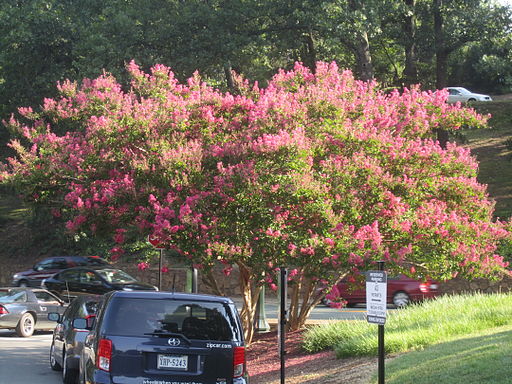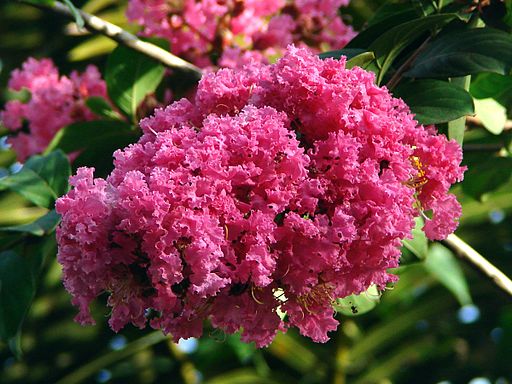The Lilac of the South
Describing Lagerstroemia species starts with what to call them in English, whether crepe myrtle or crape myrtle. Both spellings are correct and have their adherents, and even a botanical pedant would have no basis for sneering at either preference. It is a multi-stemmed small tree originally from southern and southeastern Asia, but to stop there is to ignore the enormous variety of size, flower color, and shape of this plant that has become so ubiquitous in the southern United States that it has become known as the Lilac of the South.
The hardiness zones where crepe myrtle takes over from the common lilac, Syringa vulgaris, are 6 and 7, or roughly a horizontal line through the country’s mid-section. Besides differences in cold hardiness, there are differences in size and shape, with lilac being more of a large, rounded shrub, while crepe myrtle ranges from a small shrub to a medium-sized tree and is generally vase-shaped. Lilac flowers in spring and its flowers are always fragrant; crepe myrtle flowers in summer and, depending on variety, its flowers may or may not be fragrant. Some crepe myrtle varieties, like the white flowered “Natchez”, have exfoliating bark that adds to their winter interest. Lilac is not known for any particular winter interest. Differences aside, each plant holds a favored place, North or South, that marks them out as special and at the same time as necessities in every garden.

Crepe myrtle trees on the grounds of the University of Virginia in Charlottesville, Virginia; photo by Billy Hathorn.

Crepe myrtle flowers, showing their crinkled appearance; photo by Flickr user Hafiz Issadeen.
What a shame then that every late winter crepe myrtles throughout the South are subjected to topping by “professionals” on landscaping crews and, like the practice of volcano mulching also carried out by “professionals”, homeowners then feel encouraged to mimic the skulduggery of the “professionals” in their own yards. Topping crepe myrtles this way is known as “crepe murder”, and it is not a good or wise practice.
People can of course do what they like to their own crepe myrtles. They should not, however, continue to be able to get away with spouting bogus reasons for murdering their innocent, flowering friends. If they wanted to keep its size in check, they could have planted a shorter variety to suit the location in the beginning, rather than subject the poor plant they did choose to violence year after year. Don’t let them try to claim the high ground by saying they are pollarding, either, because 99% of these knuckle-draggers couldn’t identify a proper pollard if it descended out of the trees and bit them on the buttocks. No, they are doing it strictly from a deep-seated monkey see, monkey do limbic reflex that is not subject to conscious control. And giving the reason of promoting flowering is also bogus, though because four to six months elapse between butchering and flowering, and the American attention span is very short, almost no one thinks to disprove this claim. To honor the memory and teachings of Dr. Alex Shigo, the Father of Modern Arboriculture, the Lilac of the South deserves better.
― Izzy
― Izzy


Winter interest created by the branch architecture of a well-pruned, or at least unmolested, crepe myrtle; photo by Berean Hunter.
